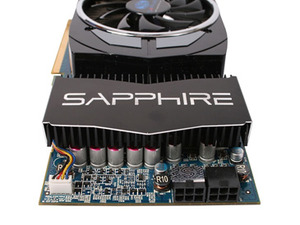Conclusions
We've been impressed by the Vapor-X cooler before, and this card continues the trend. The cooler is effective and quiet, and those are the two fundamental things that it should achieve.The strategy of using such a premium cooler on a non-overclocked card also makes sense - typically pre-overclocked cards don't offer much extra performance over stock-speed cards and yet the R&D time spent on screening and speed-binning GPUs adds a hefty price premium.
However, our fairly modest 810MHz GPU overclock (from 750MHz) puts a slight doubt in our mind. Typically a pre-overclocked card will be a better overclocker, even if the factory overclock is only minor; after all, the GPU has already gone through a screening process to see if it can handle a higher than normal frequency. We've seen 850MHz from pre-overclocked HD 4870 cards, for example. While it may seem that we're only talking about a paltry 30MHz, the absence of GPU screening for any stock-speed card (not just this one) means that DIY overclocking might hit a wall at much lower frequencies than if you were using a pre-overclocked GPU, however you pay your money and take the chance.
Conversely, if you're not really into overclocking, then it's great that you're only going to paying for the excellent cooling hardware and not the extra speed-binning R&D, and that for you, is probably the most important part.
As far as performance goes, the extra 1GB of memory only made a difference in a couple of our test games. Only the resource-hungry S.T.A.L.K.E.R. and the GPU-friendly GRID could use the extra video memory at every resolution, while Fallout 3 only ran slightly quicker on the 2GB card at 2,560 x ,1600 - that's a 30" monitor resolution.
Even in S.T.A.L.K.E.R. the difference was only a couple of fps (though that's roughly eight to nine percent faster) and only at resolutions below 2,560 x 1,600. In GRID we merely saw a slightly higher average from the Vapor-X than the 1GB HD 4870, and as this game is so GPU-friendly that made no experiential difference. Crysis, Far Cry 2 and Call of Duty: World at War couldn't care less about the extra 1GB.
That's not to say that a 2GB graphics card is pointless however - we remember the days when only Doom 3 could take advantage of 512MB of video memory and now most games want 1GB. However, if you're banking on every game in future wanting 2GB of graphics memory, this isn't the card to do it with - for a long-term bet such as this, you'd want a faster GPU, one that'll almost definitely handle every game at 1,920 x 1,200 for the next couple of years - of which will undoubtedly come with faster memory too.
Owners of 32-bit operating systems should be wary of 2GB graphics cards too. The problem comes from the fact that a 32-bit operating system has only 4GB of physical address space (essentially, the most RAM it can access), from which is must reserve memory for all the devices in a system.
A 2GB graphics card will reserve 2GB of space for itself, then add to this the space that the other devices in a system will try to reserve and you could find a PC and 32-bit OS that can only access 1.5GB of main system memory (RAM) no matter how much is physically installed. A 64-bit operating system can address plenty more, though Vista Home Premium 64-bit can only address up to 16GB and Vista Home Basic 64-bit only 8GB, as you can read on MSDN - this means for those with Core i7 systems where 16GB is a possibility, it might be worth keeping an eye out.
Final Thoughts...
Of course, the relative merits of 2GB of graphics memory is academic, as a reference-design GeForce GTX 275 costs the same as the Sapphire Vapor-X and is faster in all situations bar Fallout 3. In some games the performance advantage is marginal, in others it's more pronounced, but overall, the GTX 275 has the Vapor-X beaten for performance.However, the GTX 275 is a louder card than the Vapor-X, though not obnoxiously so, and it ships with even less memory than the standard HD 4870, let alone the 2GB Sapphire. It's hardly comparable on the "future-proofing memory footprint" stakes.
If quietness is more of a concern then the Vapor-X is worth a look, especially as in very few cases does the extra performance of the GTX 275 mean that it can run a game smoothly at a resolution or detail setting that the Vapor-X can't. At the end of the day, we'd still go for the extra speed of the GTX 275 over the quietness of the Sapphire Vapor-X, however, because when we're gaming the sound will be cranked up anyway.
Sapphire has a great alternative with its Vapor-X and we applaud its cooling innovation still, but 2GB offers very limited appeal and Sapphire's own pre-overclocked and very quiet Toxic is £46 cheaper! Having already looked at and loved the Toxic, we'd prefer to grab that instead.
- Features
- x
- x
- x
- x
- x
- x
- x
- x
- x
- -
- 9/10
- Performance
- x
- x
- x
- x
- x
- x
- x
- -
- -
- -
- 7/10
- Value
- x
- x
- x
- x
- x
- x
- -
- -
- -
- -
- 6/10
- Overall
- x
- x
- x
- x
- x
- x
- x
- -
- -
- -
- 7/10

MSI MPG Velox 100R Chassis Review
October 14 2021 | 15:04












Want to comment? Please log in.